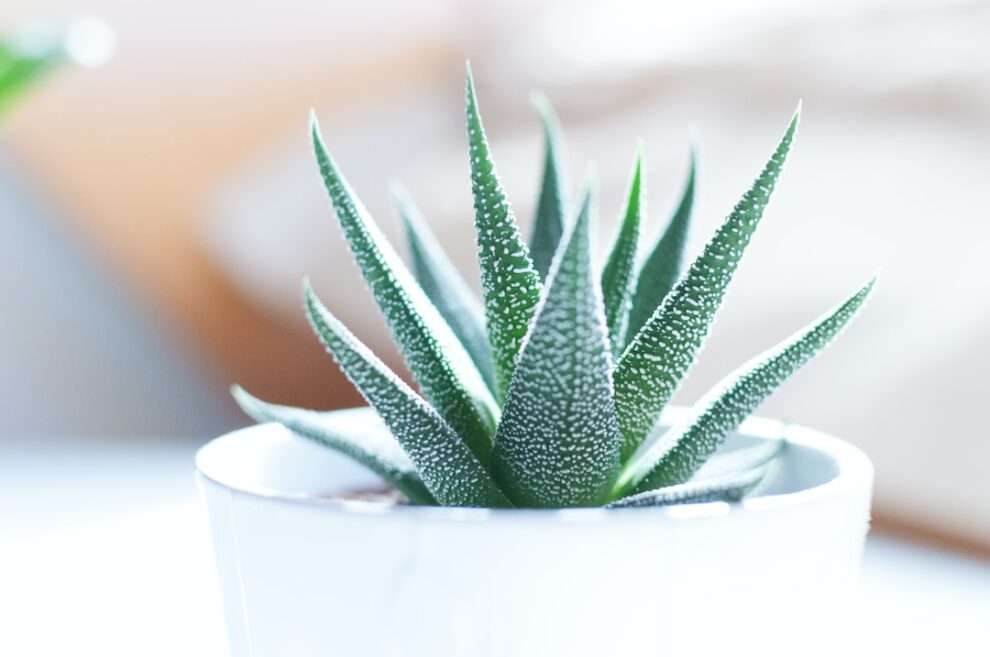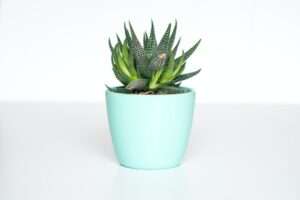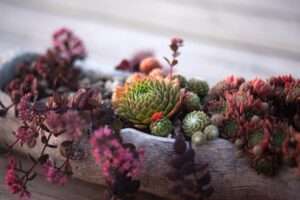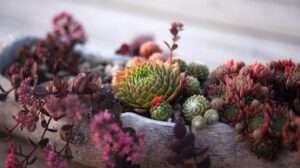Succulents have become increasingly popular in recent years due to their unique and beautiful appearance, as well as their reputation for being low-maintenance plants. However, despite their hardy nature, succulents still require proper care in order to thrive and live a long and healthy life. In this article, we will explore the various aspects of succulent care, including overwatering, sunlight needs, soil quality, pest management, potting techniques, temperature and humidity control, pruning and propagation tips, common diseases and fungal infections, managing root rot, and troubleshooting leaf loss and other issues.
Overwatering: Signs and Solutions for Succulent Care
One of the most common mistakes made in succulent care is overwatering. Succulents are adapted to survive in arid conditions and have the ability to store water in their leaves and stems. However, when they are overwatered, their roots become waterlogged and can rot, leading to the death of the plant.
Signs of overwatering in succulents include yellowing or wilting leaves, mushy or blackened stems or roots, and a foul odor coming from the soil. To prevent overwatering, it is important to understand the watering needs of your specific succulent species. Most succulents prefer to be watered thoroughly but infrequently. Allow the soil to dry out completely between waterings.
If you have overwatered your succulent and notice signs of root rot or other damage, there are a few solutions you can try. First, remove the plant from its pot and inspect the roots. Trim away any rotting or damaged roots with clean scissors or shears. Allow the plant to dry out completely before repotting it in fresh, well-draining soil. Be sure to adjust your watering habits moving forward to prevent future overwatering.
Understanding Sunlight Needs for Healthy Succulent Growth
Sunlight is essential for the healthy growth of succulents. Most succulents require at least six hours of direct sunlight each day in order to thrive. Without enough sunlight, succulents may become etiolated, meaning they will stretch and become leggy as they try to reach for more light. This can result in weak and unhealthy plants.
There are different types of sunlight and each has its own effects on succulents. Full sun refers to direct sunlight for the majority of the day, while partial sun or partial shade refers to areas that receive a few hours of direct sunlight each day. Some succulents can tolerate partial shade, but most prefer full sun.
To provide proper sunlight for your succulents, it is important to place them in a location that receives adequate sunlight throughout the day. South-facing windows are usually the best option, as they receive the most sunlight. If you do not have access to a sunny window, you can also use grow lights to supplement the light your succulents receive.
Soil Quality and Nutrient Management for Succulent Health
Soil quality is crucial for the health of succulents. Succulents require well-draining soil that allows excess water to flow out easily. Using regular potting soil or garden soil can lead to waterlogged roots and root rot.
There are several types of soil that are suitable for succulents, including cactus soil, sandy soil, and a mix of potting soil and perlite or pumice. Cactus soil is specifically formulated for succulents and provides excellent drainage. Sandy soil is also a good option as it allows water to flow through quickly.
In addition to proper soil quality, nutrient management is important for succulent health. Succulents do not require a lot of nutrients and can actually be harmed by over-fertilization. It is best to use a balanced, water-soluble fertilizer diluted to half strength and apply it sparingly, usually once or twice a year during the growing season.
Identifying and Treating Pests in Succulent Care
Pests can be a common problem in succulent care. Some of the most common pests that affect succulents include mealybugs, aphids, spider mites, and scale insects. These pests can cause damage to the leaves and stems of succulents, leading to stunted growth and even death if left untreated.
Signs of pest infestation in succulents include small insects on the leaves or stems, sticky residue on the plant, yellowing or wilting leaves, and distorted growth. To treat and prevent pest infestations in succulents, it is important to regularly inspect your plants for signs of pests and take action as soon as you notice any.
There are several methods for treating pests in succulents. One option is to use insecticidal soap or neem oil, which can be sprayed directly onto the affected areas of the plant. Another option is to physically remove the pests by wiping them off with a cotton swab dipped in rubbing alcohol. It is also important to isolate any infested plants to prevent the pests from spreading to other plants.
Proper Potting and Repotting Techniques for Succulents

Proper potting is essential for the health of succulents. Choosing the right pot is important as it affects drainage and airflow around the roots. Succulents prefer pots with drainage holes to allow excess water to escape. If your pot does not have drainage holes, you can add a layer of gravel or pebbles at the bottom to help with drainage.
When repotting succulents, it is important to choose a pot that is slightly larger than the current one. This allows room for growth without overwhelming the plant. Gently remove the plant from its current pot, being careful not to damage the roots. Place the plant in the new pot and fill in the gaps with fresh, well-draining soil. Water the plant lightly after repotting and allow it to settle in its new home.
Temperature and Humidity Control for Optimal Succulent Care
Temperature and humidity levels play a crucial role in the health and growth of succulents. Most succulents prefer temperatures between 60-80°F (15-27°C). Extreme temperatures, both hot and cold, can cause stress to succulents and may even lead to their death.
In addition to temperature, humidity levels also affect succulent care. Succulents are adapted to low humidity environments and can be sensitive to high humidity levels. High humidity can lead to fungal infections and rot in succulents. It is important to provide adequate airflow around your succulents to prevent excess moisture buildup.
To control temperature and humidity for succulent care, it is important to place your plants in a location that provides the ideal conditions. Avoid placing them near drafty windows or heating vents, as this can cause temperature fluctuations. If you live in an area with high humidity, you can use a dehumidifier or a fan to help circulate air around your plants.
Pruning and Propagation Tips for Succulent Maintenance
Pruning is an important aspect of succulent care as it helps promote healthy growth and prevents legginess. Pruning also allows you to remove any dead or damaged leaves or stems, which can attract pests or lead to disease.
To prune succulents, use clean scissors or shears to remove any dead or damaged leaves or stems. You can also trim back any leggy growth to encourage a more compact shape. Be sure to disinfect your tools before and after pruning to prevent the spread of disease.
Propagation is another important technique in succulent care. Succulents can be easily propagated through stem or leaf cuttings. To propagate succulents, simply take a stem or leaf cutting and allow it to dry out for a few days. Once the cut end has calloused over, place the cutting in well-draining soil and water lightly. Over time, the cutting will develop roots and grow into a new plant.
Common Diseases and Fungal Infections in Succulent Care
Despite their reputation for being hardy plants, succulents are still susceptible to diseases and fungal infections. Some common diseases and fungal infections that can affect succulents include powdery mildew, root rot, and bacterial soft rot.
Signs of diseases and fungal infections in succulents include discolored or distorted leaves, wilting or drooping stems, and a foul odor coming from the plant. To treat and prevent diseases and fungal infections in succulents, it is important to provide proper care and maintain good hygiene practices.
If you notice signs of disease or fungal infection in your succulent, remove any affected leaves or stems immediately to prevent the spread of the infection. Adjust your watering habits to prevent overwatering, as this can contribute to the development of fungal infections. If the infection persists, you may need to use a fungicide specifically formulated for succulents.
Managing Root Rot in Succulent Care
Root rot is a common problem in succulent care and is usually caused by overwatering or poor drainage. When the roots of a succulent become waterlogged, they can rot and lead to the death of the plant.
Signs of root rot in succulents include mushy or blackened roots, yellowing or wilting leaves, and a foul odor coming from the soil. To prevent and treat root rot in succulents, it is important to provide proper drainage and adjust your watering habits.
To prevent root rot, make sure your succulents are planted in well-draining soil and pots with drainage holes. Allow the soil to dry out completely between waterings and avoid overwatering. If you notice signs of root rot, remove the plant from its pot and trim away any rotting or damaged roots. Allow the plant to dry out completely before repotting it in fresh, well-draining soil.
Troubleshooting Leaf Loss and Other Issues in Succulent Care
Leaf loss and other issues can occur in succulent care for a variety of reasons. Some common issues that succulents may face include leaf loss, discoloration, wilting, and stunted growth.
Signs of leaf loss and other issues in succulents can vary depending on the specific problem. Leaf loss can be caused by overwatering, underwatering, pests, or disease. Discoloration can be caused by sunburn, nutrient deficiencies, or disease. Wilting can be caused by overwatering or underwatering. Stunted growth can be caused by lack of sunlight or nutrient deficiencies.
To troubleshoot and prevent issues in succulent care, it is important to provide proper care and address any problems as soon as they arise. Adjust your watering habits to prevent overwatering or underwatering. Provide adequate sunlight and adjust the position of your plants if they are experiencing sunburn. Monitor your plants for signs of pests or disease and take action immediately if you notice any.
Proper care is essential for the health and longevity of succulents. By understanding the various aspects of succulent care, including overwatering, sunlight needs, soil quality, pest management, potting techniques, temperature and humidity control, pruning and propagation tips, common diseases and fungal infections, managing root rot, and troubleshooting leaf loss and other issues, you can ensure that your succulents thrive and bring beauty to your home or garden for years to come. Remember to always provide the right conditions and adjust your care routine as needed to meet the specific needs of your succulent species.
If you’re having trouble with your succulent care, you might find this article on “Creating a Lush and Low-Maintenance Oasis: Tips for Designing Your Own Succulent Garden” helpful. It provides valuable insights and tips on how to design a beautiful succulent garden that requires minimal maintenance. Check it out here.
FAQs
What are succulents?
Succulents are plants that store water in their leaves, stems, and roots. They come in a variety of shapes, sizes, and colors and are popular for their low maintenance and unique appearance.
What are some common problems with succulent care?
Common problems with succulent care include overwatering, underwatering, improper soil, lack of sunlight, and pest infestations.
How do I know if my succulent is overwatered?
Signs of overwatering in succulents include yellowing or mushy leaves, a soft or squishy stem, and a foul odor coming from the soil.
How do I know if my succulent is underwatered?
Signs of underwatering in succulents include shriveled or wrinkled leaves, a dry and brittle stem, and soil that is completely dry.
What kind of soil do succulents need?
Succulents need well-draining soil that is specifically formulated for their needs. A mix of sand, perlite, and potting soil is a good option.
How much sunlight do succulents need?
Most succulents need at least six hours of direct sunlight per day. However, some varieties can tolerate less sunlight and may even prefer partial shade.
What are some common pests that affect succulents?
Common pests that affect succulents include mealybugs, spider mites, and scale insects. These pests can cause damage to the leaves and stem of the plant and should be treated promptly.
How do I treat pest infestations on my succulent?
Pest infestations on succulents can be treated with insecticidal soap or neem oil. It is important to follow the instructions on the product label and to treat the plant regularly until the infestation is gone.

















Add Comment